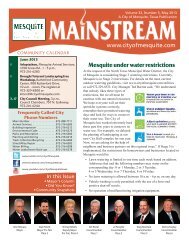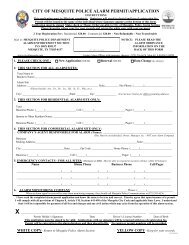airport/documents/Mesquite Master Plan Final.pdf - The City of ...
airport/documents/Mesquite Master Plan Final.pdf - The City of ...
airport/documents/Mesquite Master Plan Final.pdf - The City of ...
You also want an ePaper? Increase the reach of your titles
YUMPU automatically turns print PDFs into web optimized ePapers that Google loves.
<strong>The</strong> active general aviation aircraft<br />
fleet is expected to increase at an<br />
average annual rate <strong>of</strong> 1.1 percent over<br />
the 12-year forecast period, increasing<br />
from 210,600 in 2003, to 240,070 in<br />
2016. This growth includes the addition<br />
<strong>of</strong> a new aircraft category, light sport<br />
aircraft, which is expected to enter the<br />
active fleet in 2005, and account for<br />
15,410 aircraft in 2016. Light sport<br />
aircraft include small fixed-wing<br />
airplanes, powered-parachutes, gyroplanes,<br />
ultra-lights, and others.<br />
FAA forecasts identify two general<br />
aviation economies that follow different<br />
market patterns. <strong>The</strong> turbojet fleet is<br />
expected to increase at an average<br />
annual rate <strong>of</strong> 5.4 percent, increasing<br />
from 8,153 in 2003, to 15,900 in 2016.<br />
Factors leading to this substantial<br />
growth include expected strong U.S.<br />
and global economic growth; the<br />
continued success <strong>of</strong> fractionalownership<br />
programs; a continuation <strong>of</strong><br />
the shift from commercial air travel to<br />
corporate/business air travel by<br />
business travelers and corporations. In<br />
addition, new micro jets will begin to<br />
enter the fleet in 2006, and grow to<br />
4,500 aircraft by 2016. <strong>The</strong>se aircraft<br />
are expected to stimulate the market for<br />
on-demand air taxis.<br />
Exhibit 2B depicts the FAA forecast for<br />
active general aviation aircraft in the<br />
United States. <strong>The</strong> number <strong>of</strong> single<br />
engine piston aircraft is projected to<br />
reach 148,000 in 2015, which represents<br />
an average annual growth rate <strong>of</strong> 0.2<br />
percent. During this same time, the<br />
number <strong>of</strong> active multi-engine piston<br />
aircraft in the fleet is expected to<br />
decline by 0.2 percent, resulting in a<br />
2-11<br />
total <strong>of</strong> 17,235 aircraft in 2016. <strong>The</strong><br />
number <strong>of</strong> turboprop aircraft is expected<br />
to increase at an average annual rate <strong>of</strong><br />
3.7 percent over the 12-year forecast<br />
period, to 8,400 active aircraft. <strong>The</strong><br />
rotorcraft fleet is forecast to grow 1.2<br />
percent annually through 2016, while<br />
and the number <strong>of</strong> experimental aircraft<br />
is projected to increase from 20,603 in<br />
2003, to 21,380 in 2010. <strong>The</strong>reafter, the<br />
growth in experimental aircraft is<br />
expected to flatten, primarily due to the<br />
growth in sport aircraft.<br />
<strong>The</strong> declines in the aircraft utilization<br />
rates experienced in 2000 (down 3.2<br />
percent) and 2001 (down 7.2 percent)<br />
were due, in part, to higher fuel prices<br />
and the 2001 U.S. economic recession.<br />
However, the restrictions placed on<br />
general aviation in the aftermath <strong>of</strong> the<br />
9/11 events, contributed heavily to the<br />
decline in utilization in 2001. A strong<br />
recovery in the U.S. economy in 2004<br />
and 2005 has led to increased<br />
utilization rates for most categories <strong>of</strong><br />
general aviation aircraft.<br />
<strong>The</strong> total pilot population is projected to<br />
increase from an estimated 618,633 in<br />
2004, to 750,260 by 2016, which<br />
represents an average annual growth<br />
rate <strong>of</strong> 1.6 percent. <strong>The</strong> student pilot<br />
population increased 0.7 percent in<br />
2004, and is forecast to increase at an<br />
annual rate <strong>of</strong> 1.8 percent over the 12year<br />
forecast period, reaching a total <strong>of</strong><br />
108,800 in 2016. Growth rates for the<br />
other pilot categories over the forecast<br />
period are as follows: airline transport<br />
pilots, up 1.7 percent; recreational<br />
pilots, up 1.6 percent; rotorcraft only, up<br />
1.2 percent; and glider only, up 0.2<br />
percent.




